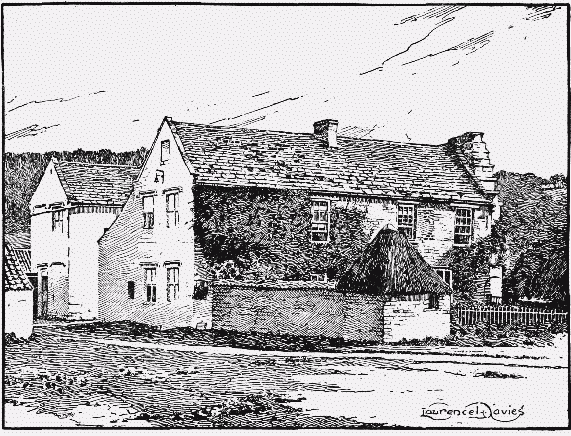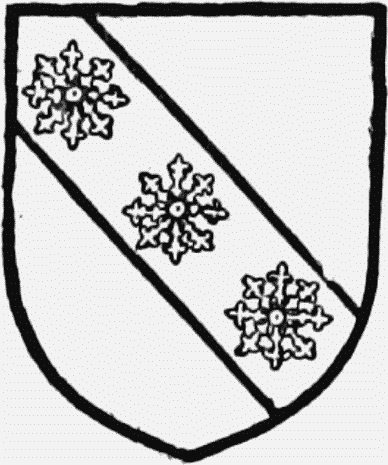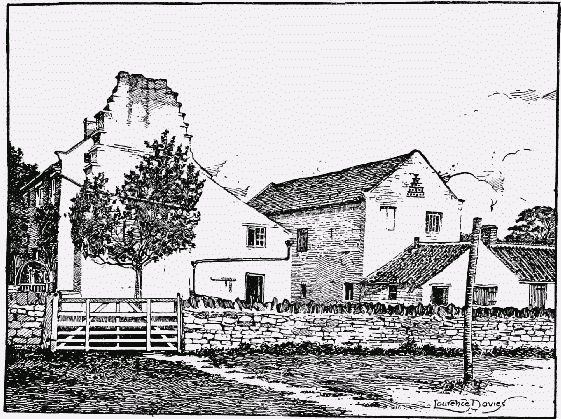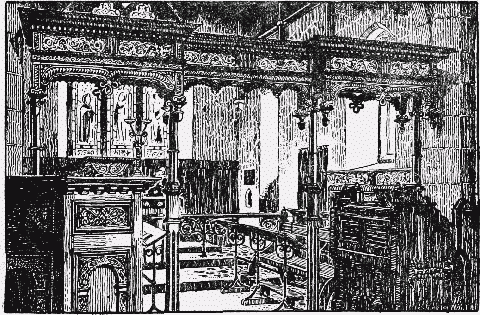A History of the County of York North Riding: Volume 1. Originally published by Victoria County History, London, 1914.
This free content was digitised by double rekeying. All rights reserved.
'Parishes: Stonegrave', in A History of the County of York North Riding: Volume 1, ed. William Page (London, 1914), British History Online https://prod.british-history.ac.uk/vch/yorks/north/vol1/pp561-566 [accessed 19 April 2025].
'Parishes: Stonegrave', in A History of the County of York North Riding: Volume 1. Edited by William Page (London, 1914), British History Online, accessed April 19, 2025, https://prod.british-history.ac.uk/vch/yorks/north/vol1/pp561-566.
"Parishes: Stonegrave". A History of the County of York North Riding: Volume 1. Ed. William Page (London, 1914), British History Online. Web. 19 April 2025. https://prod.british-history.ac.uk/vch/yorks/north/vol1/pp561-566.
In this section
STONEGRAVE
Stanegrif, Steinegrif (xi cent.); Steingreve, Steingrive (xii-xiii cent.); Stangreve, Stayngref (xiii-xv cent.).
This parish consisted in 1831 of the townships of West Ness, East Newton, Laysthorpe and Stonegrave. (fn. 1) Of these West Ness was in 1887 amalgamated with East Ness, formerly in Hovingham parish (q.v.). Waterholme, near East Ness, is the residence of Mr. R. C. Dixon. Including East and West Ness the parish has an area of 3,262 acres, and excluding Newton and Laysthorpe (941 acres) 858 acres are arable land, 974 permanent grass and 47 woods and plantations. (fn. 2) The chief crops raised are wheat, barley, oats and turnips. The parish lies on alluvium, corallian beds, Oxford clay, Kimmeridge clay and Keuper marls. Stone quarries are worked at East Newton and Laysthorpe. An Inclosure Act was passed in 1775–6. (fn. 3) The land varies from 125 ft. to 325 ft. above the ordnance datum. The village is situated at the foot of Cauklass Bank and is built along the road from Oswaldkirk, the houses being mostly of stone with tiled roofs. The church stands at the west end of the village in a churchyard of moderate size. In a field to the south of the church are distinct traces of a moat, which probably surrounded the original manor-house. The rectory appears to be of early 18th-century date, but has been considerably modernized and repaired. The capital messuage of Stonegrave is mentioned in 1370. (fn. 4)
Lying to the east of a by-road running north from the main road midway between Oswaldkirk and Nunnington is East Newton Hall, mentioned in 1638, (fn. 5) now used as a farm-house. The building, which is of stone, with a stone slate roof, is two stories in height with an attic and dates from early in the 17th century. It was evidently of H or E-shaped plan. The two end wings, facing east and west, and measuring about 60 ft. by 23 ft., were about 31 ft. 6 in. apart, and probably had central chimney stacks, but a little later a large chimney was built at the east end of the south wing. The connecting wing is now demolished, and only the southern wing, which has been added to in recent years, is now inhabited, the northern one being cleared of its internal partitions and used as a barn, while the inhabited wing has been so altered and repaired as almost to obliterate the original arrangement. The end walls of the side blocks, which are gabled, are treated symmetrically on the west, which was the principal front. The windows, some of which are blocked, are mullioned and transomed under square hood moulds, those in the west walls of both wings being original. In the east wall of the south block is a large stepped chimney stack. There are none of the original fittings left on the ground floor, but the two easternmost bedrooms are panelled with 17th-century panelling, and in the end one is an elaborate fireplace. The south wall, now the principal front, has been considerably altered, new windows being inserted and old ones blocked up. The north wall is concealed by later additions. The eastern end wall of the north wing was like the corresponding wall on the west, but the walls on the north and south sides have been considerably patched up and altered. On the north side of this wing is a disused well with a fine horse wheel. From the cellar at the west end of the south wing is a subterranean passage running northward. It is now built up about 40 ft. from the commencement, but probably connected the two wings in the basement. A great interest is given to the house by the Thornton Romances and the Autobiography of Mrs. Alice Thornton, (fn. 6) a daughter of the important Yorkshire house of Wandesford of Kirklington.
In 1278–9 and 1298 (fn. 7) mention is made of a forester of Stonegrave where is still Cauklass Wood. There is a public elementary school for the parishes of Stonegrave and Nunnington. Richard Barnes (1532–87), Bishop of Durham, was once incumbent of Stonegrave. (fn. 8)
Manors
Ulf, who held 6 oxgangs in STONEGRAVE before the Conquest, gave them to the church of St. Peter, York, and the archbishop held this land in 1086. (fn. 9) The remaining 5 carucates 2 oxgangs in Stonegrave and 3 carucates in Ness in this parish, then soke of Ralph Paynel's manor of Nunnington, (fn. 10) were afterwards part of the Paynel fee, (fn. 11) and remained members of the manor of Nunnington. (fn. 12)

East Newton Hall, Stonegrave, from the South-west
Simon de Stonegrave (who had a brother Henry) was tenant in 1200, (fn. 13) and father of William father of the Simon de Stonegrave (fn. 14) to whom Henry III in 1257 granted a weekly market on Monday at his manor of Stonegrave, a yearly fair on the vigil, feast and morrow of the Feast of the Holy Trinity and free warren in Stonegrave, Nunnington, Ricalf, Ness, Waterholme and the Newhay. (fn. 15) Simon married Beatrice daughter and heir of Richard son and heir of Jordan Foliot, (fn. 16) and left sons William, Peter and John. William's only child Joan died without issue, and Peter, who was lord in 1267 and died in 1267–8, also left no children. (fn. 17) John, the third brother, was repeatedly excommunicated by the Archbishop of York for seizing the issues of Stonegrave Church, and finally the greater excommunication pronounced against him in 1269 brought about his submission. (fn. 18) From his death in 1295–6 (fn. 19) this manor followed the descent of that of Nunnington (q.v.), being now in the possession of the trustees of the late Mr. Henry Rutson.
In 1276 complaint was made that John de Stonegrave prevented the king's ministers from entering his lands for any purpose, (fn. 20) and in 1279–81 he asserted immemorial right to amendment of the assize of bread and ale, and claimed free warren in Stonegrave, West Ness, &c., under the charter of Henry III. (fn. 21)
Two carucates at LAYSTHORPE (Lechestorp, xi cent.; Leystorp, Leistorp, Lasthorpe, xiii cent.; Lathrope, Lersthorpe, xvi cent.; Lastropp, Laystropp, xvii–xviii cent.) belonged to Orm before the Conquest. By 1086 they had passed to Hugh son of Baldric, (fn. 22) from whom the overlordship descended to the lords of Kirkby Moorside (fn. 23) (q.v.).
Thomas Fossard, who in 1241 granted a knight's fee in Sutton, Laysthorpe and elsewhere to Byland Abbey, (fn. 24) seems to have been mesne lord, and the manor was still held in 1618 of the manor of Suttonunder-Whitestone Cliffe, then in the possession of the Archbishop of York. (fn. 25)
Hugh Wake and Joan de Stutevill his wife confirmed to Byland Abbey all that the monks held of Thomas Fossard's fee in this place, (fn. 26) and in 1284–5 and 1316 Byland Abbey was tenant in demesne of the whole of Laysthorpe (fn. 27) and had rents here at the Dissolution. (fn. 28) The next mention found of the manor is in 1618, when William Thornton of East Newton died seised. (fn. 29) The Thorntons of East Newton remained in possession until 1692, when Thomas Comber, Dean of Durham and rector of Stonegrave, and Thomas Purchase, who had married respectively Alice and Katharine, the daughters of William Thornton, (fn. 30) conveyed both manors to Sir Brian Stapleton and others. (fn. 31) In 1722 (fn. 32) and 1751 (fn. 33) members of the family of Purchase were parties to deeds concerning the manor; in 1802 Benjamin Outram and Elizabeth his wife, Solomon Thwaite and Mary his wife, Benjamin Thwaite and Mary his wife, John Thwaite and Hannah his wife and Isaac Thwaite and Mary his wife conveyed the manor to James Horner, (fn. 34) and in 1810 Robert Sigsworth and Mary his wife conveyed it to Thomas Sigsworth. (fn. 35) In 1859 the manor was in the possession of Henry Dowker and in 1890 it was owned by Lieut.-Col. John Kendall.

Thornton of East Newton. Argent a bend gules with three escarbuncles or thereon.

East Newton Hall, Stonegrave, from the South-east.
A lordship belonging to Hexham Priory (fn. 36) at EAST NEWTON was held in 1618 as of the manor of Salton (fn. 37) (q.v.), a prebend of Hexham.
According to entries on the plea rolls (fn. 38) the manor passed by marriage from William de Newton to Thomas Thornton, whose son Robert was possibly ancestor of the transcriber of the Thornton Romances, which were in the possession of this family until late in the 16th century. (fn. 39) Robert Thornton, lord in 1620–1, received in that year a grant of free warren 'in East Newton in Laysthorpe.' (fn. 40) William Thornton, son of this Robert, left two daughters and co-heirs, of whom Katharine seems to have had Laysthorpe and Alice East Newton. Alice married Dean Comber, (fn. 41) who died in 1699; his son Thomas (fn. 42) was party to a deed concerning the manor in 1714. (fn. 43) Sir George Orby Wombwell, bart., has been the owner since at least 1857.
WEST NESS belonged to Jordan Foliot, (fn. 44) and by the marriage of his granddaughter descended to John de Stonegrave, who held it in 1284–5. (fn. 45) It has since followed the descent of the manor of Stonegrave (fn. 46) (q.v.).
Church
The church of the HOLY TRINITY consists of a chancel about 23 ft. by 16 ft. 6 in., north vestry, nave 37 ft. 2 in. by 16 ft. 9 in., north aisle 9 ft. wide, south aisle 8 ft. 4 in. wide, and a west tower 11 ft. 9 in. by 11 ft. These measurements are all internal.
The original nave appears to date from the latter half of the 11th century. About the middle of the 12th century the north arcade was opened in the north wall and a north aisle added. That this arcade was underbuilt in an older wall is proved by the fact that the skewbacks of the outer orders are of separate stones with a straight joint between each pair of arches. At a somewhat later date during the same century the south arcade was opened in the south wall and a south aisle added. The detail of this arcade is of a later type than that of the north arcade. In this case the wall appears to have been cut away in two separate portions, finally forming an arcade of two bays, divided by a square pier, each arch having its own semicircular respond against this pier. At one or other of these rebuildings the west tower was added, a conclusion indicated by the fact that the north and south walls of the tower form a straight joint with the west wall of the nave. In the first half of the 15th century the upper stage of the tower appears to have been rebuilt and a new nave roof constructed, the corbels of which still remain. All history of the fabric between the 12th and 15th centuries has been entirely obliterated by the restorations which the church has undergone during the 19th century.
In the east wall of the chancel is a modern window of three trefoiled lights. In the north wall is a single-light modern window, and to the west of this a modern two-centred arch opening into the vestry. The chancel arch and the two windows in the south wall, with the doorway between them, are also modern.
The north arcade of the nave is of three bays with round arches of two chamfered orders and circular columns and responds. The voussoirs of the two western arches are alternately of yellow sandstone and white freestone. The capitals of the columns are scalloped, with square-chamfered abaci. The capital of the eastern respond has also a scalloped capital, while the capital of the western respond is carved with a form of broad water-leaf. The carving of the capitals appears never to have been completed. The vertical faces of the scallops of the capital of the eastern column are carved on their west and south sides with six groups of three concentric circles. Apparently the sculptor intended to work them into some such forms of circular ornament as are found on the corresponding vertical faces of the capital of the western column, the four western circles of which on the south face are ornamented with foliated designs within beaded borders; the next to the eastward with a figure of a mermaid inverted, combing her hair and holding a mirror in her left hand. The easternmost on this face is carved in a similar manner to the four western circles. On the west face of the same capital are two completed circles containing ornament, a third consists merely of two concentric circles. The south arcade of the nave is of two bays with round arches of two chamfered orders each with a chamfered label. The responds are semicircular, with square abaci and moulded bases. The capitals of the responds of the eastern arch are carved with a broad water-leaf, while those of the western arch have scalloped capitals, the scallops at the angles of the eastern capital being carved in shallow relief. The necking of the west respond is carved with nailhead ornament. Between the arches, and stopped by their labels, is a chamfered string-course. In the west wall is a round-arched doorway, now leading into the tower, evidently the west doorway of the original nave. The clearstory windows are modern, but at the level of their sills are carved corbels of early 15th-century date, which must have formerly taken the feet of the principals of a contemporary roof of four bays. Two of the corbels on the north side are carved with angels bearing shields, one of which is charged with a cheveron between three thorn trees, while the other shield is blank. The remaining corbels are sculptured with heads, four being crowned.
The north aisle opens into the vestry by a modern two-centred arch of two chamfered orders. The north wall is pierced by two modern single-light windows with semicircular heads. The north doorway has also a semicircular head and appears to be modern. The west window is of a single light and similar to those in the north wall. The east window of the south aisle is a modern two-light window of 14th-century design. The two south windows, which are of similar design, and the south doorway are also modern. The west window is similar to the east window.
The tower is in three stages, the two lower of which are of 12th-century date. The original west doorway was built up and a west window of two lights with tracery within a two-centred head formed in the aperture in the 15th century. The jambs of this doorway are clearly visible. The bell-chamber is lighted on all four sides by square-headed 15thcentury windows of two transomed lights. The 12thcentury tooling is in a fine state of preservation on the interior of the second stage. The parapet is embattled, and there are modern crocketed pinnacles at the angles and in the centre of each face.
The walls of the chancel, nave and aisles have been entirely refaced on the exterior, where not a vestige of the original work remains. The roofs are modern.
The oak chancel screen bears the date 1637. The centre portion consists of a cornice and frieze, carved with running ornament, with a narrow architrave moulding below, beneath which are four small elliptical arches with internal cresting. The narrower portion of the screen on either side is crowned by the same cornice, frieze, and architrave, broken forward east and west, forming a sort of canopy, with pendant posts at each angle. The whole is supported by four small Ionic colonnettes standing on high bases, between which panelling was probably originally placed in the side portions, and gates in the centre opening. The screens which divide the vestry from the chancel and the north aisle are formed of woodwork of similar date. Some portions of wainscot work of the same period are also placed on the south wall of the chancel.
In the north wall of the north aisle is a recessed tomb dating from the first quarter of the 15th century. The south side of the base of the tomb has seven trefoiled panels with two-centred heads. On two of the panels are angels holding shields, one blank, the other charged with a cheveron between three thorn trees. These correspond exactly with the corbels in the north clearstory wall mentioned above. The base is crowned by a chamfered cornice ornamented with square flowers. On the top of the tomb are two curious effigies of a man and a woman in high relief. The male effigy has long hair with a small beard, and wears a gown reaching to his feet, and confined loosely by a leather belt at the waist. The gown has loose sleeves, beneath which are seen the tight sleeves of a tunic reaching to the palms of his hands, which are in prayer. Suspended from his left sleeve by a hook is a shield charged like that on the base, and hanging from his belt is a short dagger and strap; the head rests on a cushion. The length of the figure is 5 ft. 7½ in. The female effigy on his left, within the recess, wears a similar pleated gown buttoned down the front with waistbelt and tight wristlets turned down. The head-dress is closefitting, and the head rests on a cushion, while the hands are in prayer, and the feet rest on a lion, or perhaps a dog. The length of the figure is 5 ft. The jambs of the recess in which the tomb is partly placed are square, and perhaps have been cut away. At the springing on either side are corbels, carved with the heads of a crowned queen and a crowned clean-shaven king, perhaps meant for Henry V and his queen. The abacus, which is on a level with the crowns of the corbels, is of a poor, thin section and extends 16 in. from the recess on each side. The arch, a depressed three or four-centred one, is unusual, having a sort of internal cresting of three-leaved flowers. The arms on the base of the tomb and on the shield suspended from the arm of the male effigy are those of Thornton (fn. 47) of East Newton. From the same arms being found on the corbel in the clearstory wall described above it seems probable that the Thornton buried here must have given or bequeathed money for a new roof, as the style of these corbels coincides with the period of the costumes worn by the effigies. West of this is another tomb recess of modern date. Within it is an effigy of c. 1320, wearing a long surcoat and a coif. The legs are crossed and the feet rest on a lion. The hair appears to be long and to escape in a roll on either side of the face from beneath the coif. In the vestry is a painted canvas tablet to William Thornton, who died in 1668. On the north wall of the chancel is a small brass in memory of William son of Thomas Comber, Dean of Durham, who died in 1702. In the floor of the chancel is a slab in memory of Thomas Comber, S.T.P., Dean of Durham and also rector of Stonegrave, who died in 1699. At the west end of the south aisle, in the floor, is a tapering slab with a double marginal inscription and the indent of a shield. The inscription is nearly illegible, but the remaining portion may be read as follows:
' . . . (ro?) bertu(s?) . . . nup(er?) (rector?) . . . positus fuit die sancti georgii . . .'

Stonegrave Church: Chancel Screen
Near this slab are placed several pre-Conquest fragments sculptured with interlacing ornament, including two hog-backs. The largest fragment consists of a nearly perfect cross with equal arms connected by a circle, with a tapering stem, at the top of which is a figure, possibly representing the Ascension; in the middle of the stem is a Latin cross, and at the foot another figure, holding a book, possibly an Evangelist. The stone on which the cross at present stands was evidently the tomb slab of a lady, a pair of shears being plainly discernible, and is probably of 13th-century date. On another fragment is a Paschal Lamb. (fn. 48)
There are two bells, the treble inscribed 'Tout pour l'Eglise mdclxix,' the tenor, 'T. Comber, Rect. An. Dom. mdclxix.'
The plate is silver and consists of a cup, paten and flagon. The cup, in which the hall marks are indistinct, is probably of 1610, and the paten of 1701 is inscribed 'Patina Ecclesiae de Stonegrave ex dono Dominae Annae Bowman de Nunnington.' The flagon is inscribed 'The gift of Mr. John Pearson of Laysthorpe for the use of the Communicants belonging to Stonegrave Parish September 1st 1764.'
The registers begin in 1584.
Advowson
The advowson of the rectory belonged in 1267 to Peter de Stonegrave, lord of the manor, (fn. 49) the descent of which it continued to follow till 1554, since which date it has remained in the hands of the Crown. (fn. 50) Robert Thornton had leave from the Dean and Chapter of York in 1397–8 to celebrate mass in the chapel at East Newton during the vacancy of the see. (fn. 51) Alice widow of William Thornton and writer of the Autobiography, by her will in 1705 bequeathed £20 for rebuilding the chapel, 'long since demolished.' (fn. 52) This chapel, which was under the invocation of St. Peter, (fn. 53) was never rebuilt. (fn. 54)
Charities
A sum of £2 3s. 9d., known as the Widdington and Sunley charity, is paid by the owners of lands in Nunnington and distributed among the poor together with the income of the sum of £21 2s. 9d. consols, held by the official trustees in respect of the charities of Mrs. Comber and Mr. Thomas Comber.
In 1728 John Clark of Nunnington left a house, orchard and garth towards the repairs of the church. The property now consists of two cottages and land, producing £8 10s. yearly.